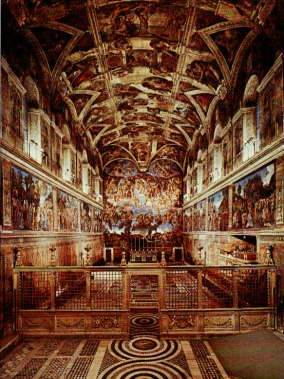The Renaissance
In about 1450, European scholars became more interested in studying the world around them. Their art became more true to life. They began to explore new lands. The new age in Europe was eventually called “the Renaissance.” Renaissance is a French word that means “rebirth.” Historians consider the Renaissance to be the beginning of modern history.
The Renaissance began in northern Italy and then spread through Europe. Italian cities such as Naples, Genoa, and Venice became centers of trade between Europe and the Middle East. Arab scholars preserved the writings of the ancient Greeks in their libraries. When the Italian cities traded with the Arabs, ideas were exchanged along with goods. These ideas, preserved from the ancient past, served as the basis of the Renaissance. When the Byzantine empire fell to Muslim Turks in 1453, many Christian scholars left Greece for Italy. The Renaissance was much more than simply studying the work of ancient scholars. It influenced painting, sculpture, and architecture. Paintings became more realistic and focused less often on religious topics. Rich families became patrons and commissioned great art. Artists advanced the Renaissance style of showing nature and depicting the feelings of people. In Britain, there was a flowering in literature and drama that included the plays of William Shakespeare.
The Renaissance began in northern Italy and then spread through Europe. Italian cities such as Naples, Genoa, and Venice became centers of trade between Europe and the Middle East. Arab scholars preserved the writings of the ancient Greeks in their libraries. When the Italian cities traded with the Arabs, ideas were exchanged along with goods. These ideas, preserved from the ancient past, served as the basis of the Renaissance. When the Byzantine empire fell to Muslim Turks in 1453, many Christian scholars left Greece for Italy. The Renaissance was much more than simply studying the work of ancient scholars. It influenced painting, sculpture, and architecture. Paintings became more realistic and focused less often on religious topics. Rich families became patrons and commissioned great art. Artists advanced the Renaissance style of showing nature and depicting the feelings of people. In Britain, there was a flowering in literature and drama that included the plays of William Shakespeare.
Leonardo Da Vinci
· Born near Florence but most of his art was done in Milan.
· ‘Most Versatile genius who ever lived’
· Anatomy and geology were his passions
· He was a perfectionist, which means that not many of his major works were finished
· Spent last few years in France living and working under Francis I
· Extremely well known for his customary backwards-mirror imaged writing to keep secrets
· ‘Most Versatile genius who ever lived’
· Anatomy and geology were his passions
· He was a perfectionist, which means that not many of his major works were finished
· Spent last few years in France living and working under Francis I
· Extremely well known for his customary backwards-mirror imaged writing to keep secrets
Major Pieces of Work
The Arno Landscape
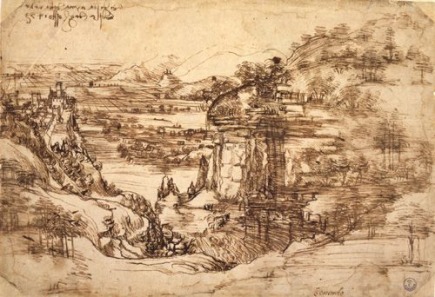
http://www.leonardodavincisecrets.com/images/gallery/Landscape%20Drawing%20of%20the %20Arno%20Valley.jpg
1437
It was his first dated work that he completed at age 21 in Florence.
It is an extremely detailed drawing faithfully reproducing items like the trees bending in the wind. The structure on the left is thought to be the castle of Montelupo while the valley in the distance is that of the Arno, hence the name. For this drawing Leonardo used pen and bister, along with some watercolour in more shaded areas.
It was his first dated work that he completed at age 21 in Florence.
It is an extremely detailed drawing faithfully reproducing items like the trees bending in the wind. The structure on the left is thought to be the castle of Montelupo while the valley in the distance is that of the Arno, hence the name. For this drawing Leonardo used pen and bister, along with some watercolour in more shaded areas.
Leonardo's Angel
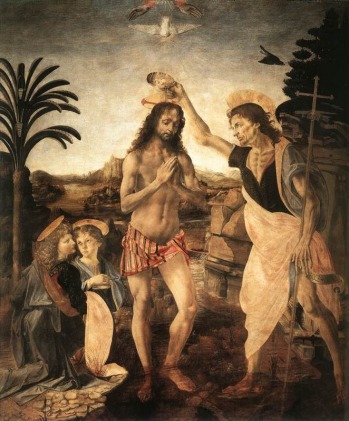
http://smarthistory.us/site/wp-content/images/leonardo_Verrochio.jpg
The famous Baptism Of Christ is by Leonardo's master, Andrea del Verrocchio, and was commissioned by the monks of San Salvi near Florence. Leonardo was 23 at the time it was painted and part of his contribution was the angel holding the mantle.Leonardo's angel has been claimed to astound Verrocchio so much because Leonardo was still only and apprentice, that he gave up painting completely.
Flying Machines

http://www.csupomona.edu/~plin/ls201/images/heli_big.jpg
He spent 20+ years trying to find ways for man to fly. His greatest and most well known accomplishment was the ‘Aerial Screw,’ otherwise known as the helicopter.
Proportions of the Human Figure (Vitruvian Man)

http://iacmusic.com/Uploads/142996_1_20_2010_9_50_00_PM_-_j-102-0013_vitruvian_man_5001.jpg
Da Vinci’s Vitruvian Man was inspired by the Roman architect and engineer, Marcus Vitruvius Pollio. In his famous book De architectura, Vitruvius proposed a concept that architecture should imitate nature in the construction of housing by using natural materials which were beautiful, durable and useful. He asserted that the invention of the Greek classical architectural orders, Doric, Ionic, and Corinthian, were developed to give the architecture of man a sense of proportion. Then, he further added this concept of proportion to the proportions of the human body, nature’s greatest work.
Mona Lisa (La Gioconda)
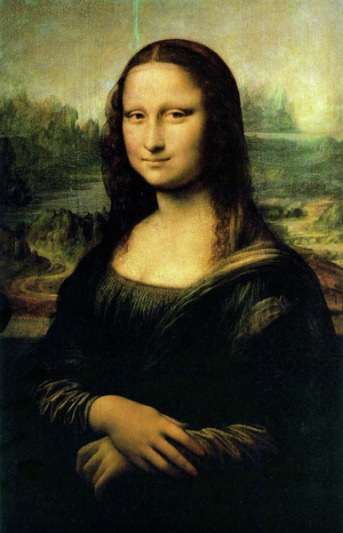
http://scrapetv.com/News/News%20Pages/Business/images-4/mona-lisa.jpg
1503.
Portrait of Lisa Gherardini, wife of a Florentine merchant.The painting is a half-length portrait and depicts a woman whose facial expression is often described as enigmatic.The ambiguity of the sitter's expression, the monumentality of the half-figure composition, and the subtle modeling of forms and atmospheric illusionism were novel qualities that have contributed to the painting's continuing fascination.
Portrait of Lisa Gherardini, wife of a Florentine merchant.The painting is a half-length portrait and depicts a woman whose facial expression is often described as enigmatic.The ambiguity of the sitter's expression, the monumentality of the half-figure composition, and the subtle modeling of forms and atmospheric illusionism were novel qualities that have contributed to the painting's continuing fascination.
The Last Supper

http://joshjackblog.files.wordpress.com/2010/01/last_supper_davinci1.jpg
1495-97.
In the Christian Gospels, the Last Supper (also called the Mystical Supper) was the last meal Jesus shared with his Twelve Apostles and disciples before his death.
In the Christian Gospels, the Last Supper (also called the Mystical Supper) was the last meal Jesus shared with his Twelve Apostles and disciples before his death.
Michelangelo
· 1475-1519
· Painter, sculptor, and poet.
· Lived in Florence
· Taken in to live with Lorenzo de Medici for 2 years. Lorenzo died so Michelangelo had to move back home with his dad.
· Even though he was so great he was a sad, highly sensitive, and a solitary figure
· ‘The Laocoon’ had a huge impact on his future work. He fell in love with the twists and turns of the sculpture. He was present for the recovering of the piece of work.
· Painter, sculptor, and poet.
· Lived in Florence
· Taken in to live with Lorenzo de Medici for 2 years. Lorenzo died so Michelangelo had to move back home with his dad.
· Even though he was so great he was a sad, highly sensitive, and a solitary figure
· ‘The Laocoon’ had a huge impact on his future work. He fell in love with the twists and turns of the sculpture. He was present for the recovering of the piece of work.
Major Pieces of Work
The Sistine Chapel
The Last Judgement
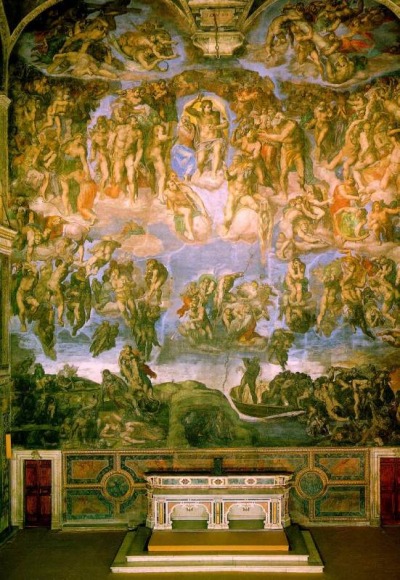
http://www.journeywithjesus.net/Essays/Michelangelo_The_Last_Judgement.jpg
On the altar wall-1536-41. Commissioned by Pop Paul III. Michelangelo worked alone. He refused to even accept help after a devastating fall while working. At the unveiling of the fresco, a huge controversy broke out about the nudity of the figures. It was highly unacceptable in a religious context. At Michelangelo’s death, drapery was painted to cover them. This particular fresco was largely inspired by the Latin hymn “Dies Israe”
Ceiling
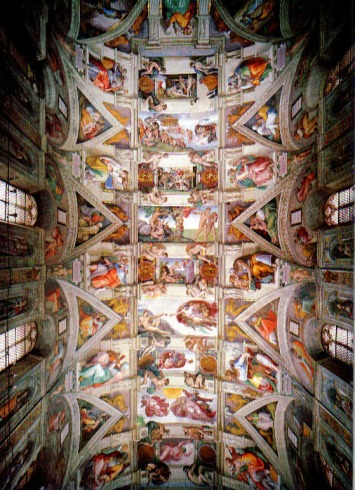
http://www.christusrex.org/www1/sistine/0B-Ceiling.jpg
· The nine scenes form Genesis make up the frescos that are on the ceiling:
1. Drunkenness of Noah
2. The deluge
3. Sacrifice of Noah
4. Temptation and Expulsion
5. Creation of Eve
6. Creation of Adam
7. Separation of land form water
8. Creation of sun, moon, Plants
9. Separating Light from Darkness
1. Drunkenness of Noah
2. The deluge
3. Sacrifice of Noah
4. Temptation and Expulsion
5. Creation of Eve
6. Creation of Adam
7. Separation of land form water
8. Creation of sun, moon, Plants
9. Separating Light from Darkness
The Duomo Pieta
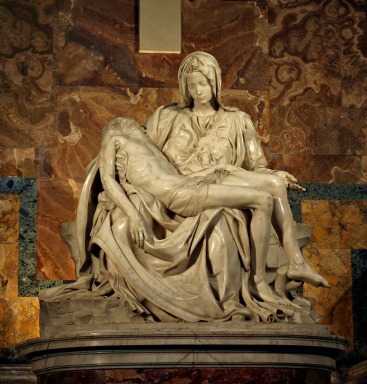
http://panathinaeos.files.wordpress.com/2009/01/michelangelos_pieta_5450_cropncleaned.jpg
· 1497-1500
Built for a French cardinal in Rome, and overall it was loved by the people, but there were a few complaints about the relatively young look of the Virgin. Other than that, people were struck with pure amazement-every fold and drapery was finely sculptured and polished.
It now currently resides in St. Peter’s, in Rome
Built for a French cardinal in Rome, and overall it was loved by the people, but there were a few complaints about the relatively young look of the Virgin. Other than that, people were struck with pure amazement-every fold and drapery was finely sculptured and polished.
It now currently resides in St. Peter’s, in Rome
David
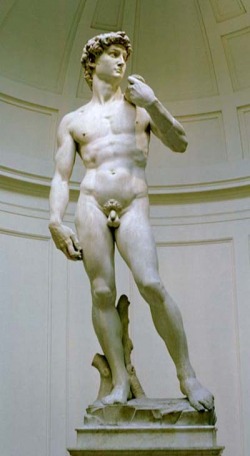
http://www.florence-tourism.com/web/images/david.jpg
· 1501-4
· 13’ 5 ¼”
· Accademia, Florence
Florentines wanted Michelangelo to make it to symbolize Republican virtues of courage and fortitude. The block of marble that he was given was shallow, and extremely flawed. He still managed to create one of the most famous sculptures, in extreme detail. David before his battle with Goliath was the pose that Michelangelo was trying to depict with this statue. He made him into a stature of anticipation and defiance.
· 13’ 5 ¼”
· Accademia, Florence
Florentines wanted Michelangelo to make it to symbolize Republican virtues of courage and fortitude. The block of marble that he was given was shallow, and extremely flawed. He still managed to create one of the most famous sculptures, in extreme detail. David before his battle with Goliath was the pose that Michelangelo was trying to depict with this statue. He made him into a stature of anticipation and defiance.
Raphael
· Seemed to be the living embodiment of the Renasissance. He was a charming and gracious man, with superlative skill.
· He was not as innovative and Leonardo or sculptural as Michelangeo, but he painted with the beauty of line and color. He had a harmony in composition that certainly surpassed the two.
· He was born in Urbine, but painted mostly in Florence and Rome.
· Illness struck him at the height of his fame and he died of a fever on his 37th birthday.
· He was not as innovative and Leonardo or sculptural as Michelangeo, but he painted with the beauty of line and color. He had a harmony in composition that certainly surpassed the two.
· He was born in Urbine, but painted mostly in Florence and Rome.
· Illness struck him at the height of his fame and he died of a fever on his 37th birthday.
Major Pieces of Work
The Betrothal of the Virgin

http://www.book530.com/paintingpic/0920c2/the-betrothal-of-the-virgin-sposalizio.jpg
Mary is tall and beautiful, and Joseph is rather distinguished. Note the disappointed suitors, one of whom is breaking his rod. The stunning tableaux in the foreground and the gorgeous harmony of palace in the background set up a space which allows the figures a wonderful freedom of movement. Though it owes something to Raphael's teacher, Pietro Perugino, it shows how far the student had moved toward assimilating the lessons of the Florentines. The painting may seem more like Athens than Nazareth but it surely is intended to suggest the ideal harmony between man and woman and citizen and city. In such a place one could be happy.
The Entombment
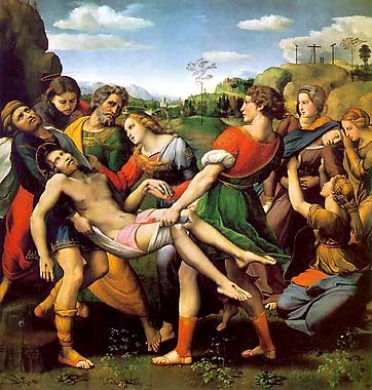
http://www.thecross-photo.com/images/raphael_entombment.jpg
This was his first attempt at a dramatic, multi-figure composition. Not only did the focus of this image come out beautifully, but the background of this painting makes a real statement as well.
The School of Athens
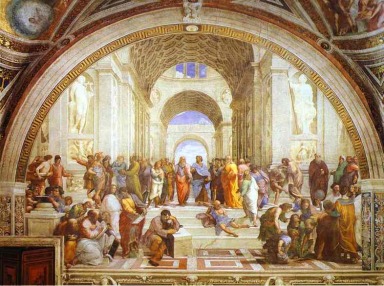
http://www.eee.metu.edu.tr/~akan/raphael30.jpg
'One of the supreme works of the Renaissance'. It contained the greatest ancient philosophers: Aristotle and Plato are in the center of this painting. They were meant to symbolize the rational pursuit of truth.
The Liberation of St. Peter
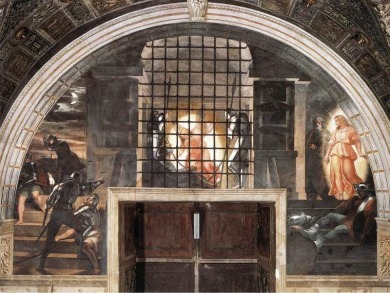
http://www.lib-art.com/imgpainting/9/3/15739-the-liberation-of-st-peter-raffaello-sanzio.jpg
One of the most imaginative art scenes in the history of art; 'Continuous representation’-showing 2 scenes form the same narrative in one painting. In this case: the center has an angel ‘rousing’ the sleeping st. peter and on the right, she leads him out of prison. This painting has been interpreted as an allegory of the deliverance of Italy from French invaders who were expelled in 1512.
The Transfiguration
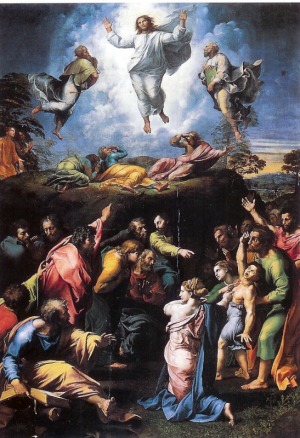
http://arthistoryfacts.com/TransfigurationByRaphael.jpg
1517-20.
This was his last piece of work which was finished at his death by the members of his studio. It was also claimed to be the ‘ultimate perfection’ by Vasari-Two different biblical episodes are shown in this painting: Above you see Christ rising between Moses and Elijah. Below you see a boy possessed by an evil spirit who is taken to the disciples to be cured.
This was his last piece of work which was finished at his death by the members of his studio. It was also claimed to be the ‘ultimate perfection’ by Vasari-Two different biblical episodes are shown in this painting: Above you see Christ rising between Moses and Elijah. Below you see a boy possessed by an evil spirit who is taken to the disciples to be cured.
Titian
· 1485-1576
· The greatest painter of the Venetian school
· Purely a painter, unlike all of the other artists listed
· Most famous artist in Europe at his death
· The greatest painter of the Venetian school
· Purely a painter, unlike all of the other artists listed
· Most famous artist in Europe at his death
Major Pieces of Work
Noli Me Tangere
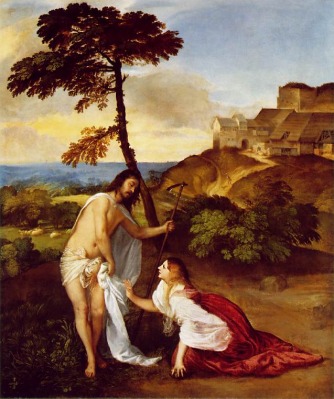
http://treecritter.files.wordpress.com/2009/07/noli_me_tangere.jpg
c1508.
Tells thestory of Christs appearance to the Magdalen, after the Resurrection. Titian shows Mary reaching out to her son, but Christ has the ‘touch me not’ action as she is doing so; hence the title "Noli Me tangere." This literally means "Don't touch me."
Tells thestory of Christs appearance to the Magdalen, after the Resurrection. Titian shows Mary reaching out to her son, but Christ has the ‘touch me not’ action as she is doing so; hence the title "Noli Me tangere." This literally means "Don't touch me."
The Assumption of the Virgin
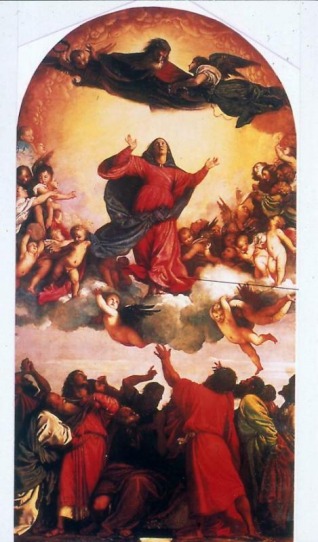
http://english.ncu.edu.tw/susanna/images/re/art02/11.JPG
1516-18.
The picture shows different events in three layers. In the lowest one, the Apostles are looking at the Virgin Mary who is flying between them and God, standing on a cloud and surrounded by celebrating and dancing angels. Next to God, who is waiting for her, is another angel holding the crown of the Holy Glory.
The picture shows different events in three layers. In the lowest one, the Apostles are looking at the Virgin Mary who is flying between them and God, standing on a cloud and surrounded by celebrating and dancing angels. Next to God, who is waiting for her, is another angel holding the crown of the Holy Glory.
Bacchus and Ariadne

http://rbvhs.vusd.k12.ca.us/teachers/roswell/apeuro/unit1/images/bacchus_ariadne.jpg
1520-23.
This painting is showing the wine god Bacchus with his followers coming across Ariadne,-the daughter of King Minos of Crete-who was abandoned by her lover, Theseus.
This painting is showing the wine god Bacchus with his followers coming across Ariadne,-the daughter of King Minos of Crete-who was abandoned by her lover, Theseus.
